Old cities & towns in Japan
Major historic cities
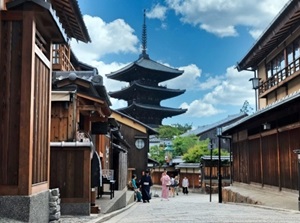
Sannen-zaka in Kyoto
Kyoto (京都) is a large city and is a popular traditional city.
Needless to say, most foreign tourists visit here while traveling Japan.
So, Kyoto is crowded with the tourists every day.
Kyoto had been the capital of Japan from 794 to 1868.
Traditional houses and many Buddhist temples remain in the city and former court culture is inherited in the city.
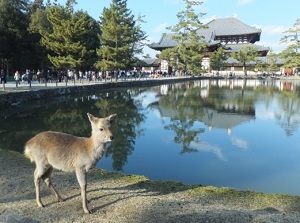
Nara Park
Nara (奈良) is located about 30 km south of Kyoto.
Nara had been the first capital of Japan based on ancient law and Buddhism from 710 to 784.
After that, the capital was moved to Kyoto.
Many old temples are dotted in the city, but the style of the buildings are slightly different from Kyoto.
Wild deer as the messenger of God are living in the city of Nara.
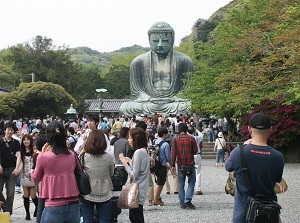
Great Buddha in Kamakura
Kamakura (鎌倉) is the city located about 40 km south of Tokyo.
The capital was in Kyoto, but the first government by samurai had been placed in Kamakura from 1192 to 1333.
The era is called Kamakura Period in Japanese history.
The narrow city area is surrounded by hills.
The palace of the government don't remain, but many Buddhist temples are dotted in the whole area.
The southern area of the city is a popular seaside.
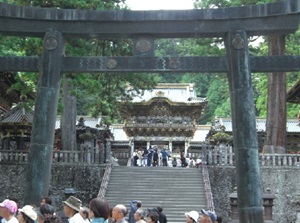
Yomeimon in Nikko Toshogu
Nikko (日光, Tochigi Pref.) is the religious city where the first Shogun was enshrined in the 17th century.
Two Shinto shrines (Nikko Toshogu, Futarasan Shrine) and a Buddhist temple (Rinnoji) are designated as World Heritage Site, and they are in the wide site surrounded by forests.
The gorgeous buildings and carvings are famous.
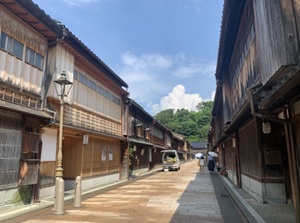
Higashi-Chaya district in Kanazawa
Kanazawa (金沢) is a local city located on the Japan Sea side.
Kanazawa Castle was built in the late 16th century, and great lords governed this area.
So Kanazawa became the fourth largest city after Edo (Tokyo), Osaka and Kyoto.
The gorgeous industries such as Kimono, craft works with gold leaf, etc. were promoted and the cultures like Kyoto developed.
So, the atmosphere of the city may be similar to Kyoto, and Kanazawa is sometimes called "Little Kyoto".
But Kyoto was the city by court nobles and Kanazawa was the city by samurai, so Kanazawa citizen say that Kanazawa is different from Kyoto.
Old cities and towns in each region
Hokkaido Tohoku Kanto Koshin-etsu Hokuriku Tokai Kansai Chugoku Shikoku Kyushu
Old cities and towns in Hokkaido Region
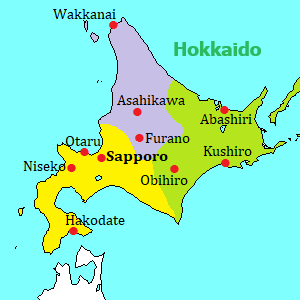
Hokkaido is an island developed from the late 19th century.
The central city is Sapporo, and it was built by the colonists from Honshu Island.
So the other cities were also built in those days.
Western-style historic buildings in the 19th to 20th centuries remain in the cities.
Otaru (小樽) is located near Sapporo.
It developed as the main port of Sapporo.
There are some historical spots around the port, and fresh "sushi" is famous.
Hakodate (函館) has been the entrance city of Hokkaido by ferry from Honshu Island.
Fishery is also a major industry and fresh squid is popular.
The morning market is famous, and there is a major onsen area in the city.
Old cities and towns in Tohoku Region
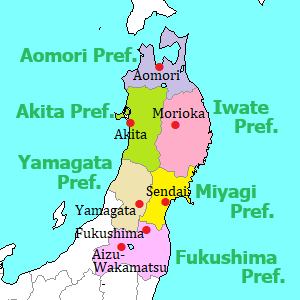
Tohoku Region is in the north of Japan, so the people had lived in the cool and severe climate.
Hirosaki (弘前, Aomori Pref.) is in the western part of the prefecture.
Hirosaki Castle is a place famous for its cherry blossoms.
Old districts and temples are dotted in the town, and some modern buildings are also found.
Kakunodate (角館, Akita Pref.) is a small town and the culture of Kyoto was introduced in the 17th century, so it is called "Little Kyoto".
Samurai houses along a street are popular.
Morioka (盛岡, Iwate Pref.) was introduced by The New York Times as one of "52 Places to go in 2023".
It is the central city of Iwate Prefecture, and there are some historical spots in the city.
Toono (遠野, Iwate Pref.) is an inland city with rural landscape and is located to the southeast of Morioka.
Many folklores of Toono had been introduced by a Japanese folklore scholar, so there are some spots about them are dotted.
Sakata (酒田, Yamagata Pref.) was a port town prospered by a maritime trade hub in the Japan Sea in the 17th to 20th centuries.
There are some spots related to the merchants in those days.
Aizu-Wakamatsu (会津若松, Fukushima Pref.) is an inland city.
It is a major castle town and has various traditional cultures.
And we can see the history of conservative samurai spirit.
Kitakata (喜多方, Fukushima Pref.) is a small city to the north of Aizu-Wakamatsu.
It is well-known as the city of many old storehouses in the 19th century.
And, "Kitakata Ramen" is one of the three most popular ramen styles in Japan.
There are 120 ramen restaurans in the small city.
Oouchi-juku (大内宿, Fukushima Pref.) was the small town with lodging facilities for travellers on the main road in samurai period.
This town keeps the traditional landscape of the period.
Old cities and towns in Kanto Region
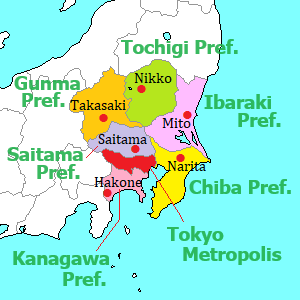
Kanto is the national capital region centering around Tokyo.
Tokyo had been called "Edo" and it is a large city created popular traditional cultures.
So, there are some traditional cities related to Edo in the surrounding areas of Tokyo.
Hakone (箱根, Kanagawa Pref.) is a popular onsen resort, and there are some volcanoes and Lake Ashi.
After Edo became the capital of Japan in 1603, the main route between Edo and Kyoto was passed through Hakone, so here was an important checkpoint of travellers at that time.
Kawagoe (川越, Saitama Pref.) was a castle town near Edo, and it prospered as a distribution center of various products to Edo.
Many old buildings remain in the city, so it is called "Little Edo".
Sawara (佐原, Chiba Pref.) is a district in Katori city.
In Edo period, here became a grain-growing district, and the water transportation to Edo also had developed.
Mito (水戸, Ibaraki Pref.) was a castle town where the Shogun family governed.
There is famous garden "Kairakuen" built by the lord of castle and a school for samurai remains.
Old cities and towns in Koshin-etsu Region
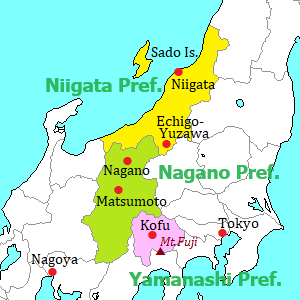
Koshin-etsu Region is a mountainous area in the central part of Japan.
A few main mountain routes were built in the 17th century, and some post town were set up.
Kofu (甲府, Yamanashi Pref.) is the city in connection with strong warlord, Takada Shingen, governed this area in the 16th century.
There are the ruin of the castle, shrine, temple and onsen resort related to him.
Obuse (小布施, Nagano Pref.) is a small rural town near Nagano city.
Sake breweries, chestnut sweets, and Ukiyoe (Japanese woodblock prints) are seen as unique combination of Japanese culture.
Azumino (安曇野, Nagano Pref.) is a small town at the foot of beautiful mountains of Northern Alps.
Many small clear rivers flow and there are many talismanic stones called as "Dososhin" protecting the village from evil.
Narai-juku (奈良井宿, Nagano Pref.) was a post town on the mountain route between Edo (Tokyo) and Kyoto.
It is along a valley in the mountains, and many old buildings are along the road.
Tsumago-juku (妻籠宿, Nagano Pref.) and Magome-juku (馬籠宿, Gifu Pref.) are the post towns about 60 km south of Narai-juku.
There is an original route between the towns, and the walking on the route is popular for the tourists.
Old cities and towns in Hokuriku Region
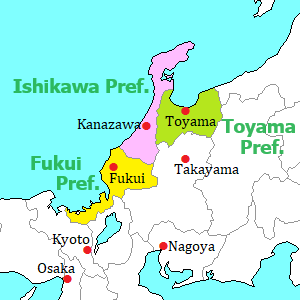
Hokuriku is the central part of the Japan Sea coast.
Kanazawa is the central city as described above.
Takaoka (高岡, Toyama Pref.) was a castle town, and he castle had been demolished in the 17th century.
But commerce and industry developed, and the old towns remain.
Gokayama (五箇山, Toyama Pref.) is a mountain area and small villages of old houses with traditional rafter roof are dotted.
Similar Shirakawa-go village is close to Gokayama.
Obama (小浜, Fukui Pref.) is a city facing the Japan Sea.
It had been the city for sending the marine products of Japan Sea to the capital Kyoto.
So the culture of court nobles in Kyoto remains in the old town.
Old cities and towns in Tokai Region
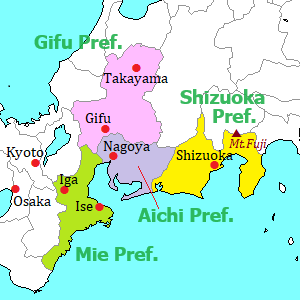
Tokai Region is located between two ancient capitals, Kyoto and Tokyo.
Important routes connecting both cities had been developed.
Various industries developed, so most cities and towns have been modernized.
The main route "Tokaido" passes through Shizuoka Prefecture and the travellers have watched Mt.Fuji on the way.
In Aichi and Gifu Prefectures, strong military commanders of samurai who unified Japan battled in the middle years.
Mie Prefecture has the most sacred Shinto shrine and the town produced Ninja.
Arimatsu (有松, Aichi Pref.) is a district in big Nagoya city and it is on the old road Tokaido.
Traditonal houses remain along the street, and tie-dyeing of cotton cloth called "Arimatsu Shibori" had been created.
Seki-juku (関宿, Mie Pref.) had been a post-station town on Tokaido route, and it was an important point of transportation.
Many old buildings remain along the street
Iga (伊賀, Mie Pref.) is a city in a basin not so far from the ancient capital Kyoto.
It is said that "Ninja" originated for self-defence of this area.
There are the castle and the museum of Ninja.
Takayama (高山, Gifu Pref.) had been a castle town in the mountain, and many old buildings remain.
Morning market, Sake breweries, gorgeous festival, etc. are the attractive spots for tourists.
Shirakawa-go (白川郷, Gifu Pref.) is located to the west of Takayama city.
Many houses with traditional rafter roof are popular.
Similar Gokayama area in Toyama Prefcture is close to Shirakawa-go.
Hida-Furukawa (飛騨古川) is a small town located to the northwest of Takayama city.
It is like small Takayama, and there are some traditional spots.
Japanese anime film set in this town was a big hit in Japan in 2016, so tourists knew this town.
Gujo-Hachiman (郡上八幡) is a castle town along a river in the mountain.
Old town with the canals flowing pure water is attractive, and all-night dance festival in summer is famous.
Old cities and towns in Kansai Region
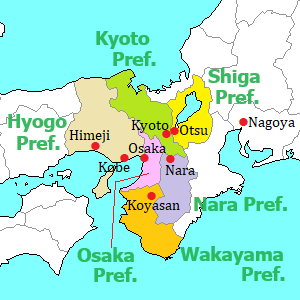
Kansai Region had been the center of ancient Japan.
As above, Kyoto and Nara were the capital cities.
Osaka was the central city of commerce, and it is the central city of western Japan.
These are the major historical cities not only in Kansai Region but also in Japan.
Shiga Prefecture to the east of Kyoto has a large Lake Biwa and main routes from Edo (Tokyo) to Kyoto.
So, traditional towns are dotted.
Oumihachiman (近江八幡, Shiga Pref.) is a city on the southeastern coast of Lake Biwa.
It was a castle town developed and there are the moats in the town.
Koka (甲賀, Shiga Pref.) is located to the south of Oumihachiman, and is also "Koga".
The city is near Iga city, and it had produced "Ninja" with Iga.
There are some spots about Ninja.
Nagahama (長浜, Shiga Pref.) is a city by the north part of Lake Biwa.
It was a castle town and many talented merchants were produced in Edo Period.
There is an old district.
Kyoto Prefecture includes big Kyoto city as a sightseeing city, but there are also some local areas.
Miyama (美山, Kyoto Pref.) is a small village is located about 40 km north of Kyoto city.
Traditional houses with thatched roof gathered in the village.
Ine (伊根, Kyoto Pref.) is a small fishing village facing the Sea of Japan.
Unique houses of fisherman called Funaya line along the seaside.
Old cities and towns in Chugoku Region
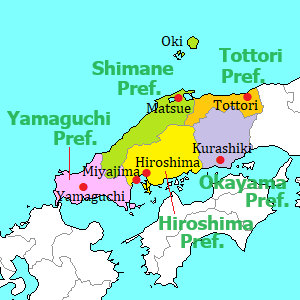
Chugoku Region is a long area located to the west of ancient capital Kyoto and Osaka.
The area along the southern coast facing Seto Inland Sea is called "San-yo", and the route along the northern coast facing the Sea of Japan is called "San-in".
Various historic towns are dotted on both routes.
Kurashiki (倉敷, Okayama Pref.) was a distribution center of various products of the area in the 17th century.
A district is designated as a national conservation area of traditional buildings.
Tomonoura (鞆の浦, Hiroshima Pref.) is a small port town facing Seto Inland Sea, and there is old town around the cove.
The ships sailing on the sea had waited for the change of the flow in this port in the old times.
Onomichi (尾道, Hiroshima Pref.) is a city facing Seto Inland sea, but there is an island just before the town and the sea is like a canal.
The town with many Buddhist temple is on the slope and the scenery is tasteful.
Takehara (竹原, Hiroshima Pref.) is a small town in a valley near Seto Inland Sea, and it prospered with salt production and sake brewery in the 17th century.
It has the quiet and traditional atmosphere.
Matsue (松江, Shimane Pref.) is a lakeside city and there is the castle designated as national treasure.
Old samurai town remain by the castle and the pleasure boat is operated in the moats of the castle.
Tsuwano (津和野, Shimane Pref.) is a small castle town in a valley and is called "little Kyoto".
The town has a history of oppression toward Christians by the Meiji government in the 1860s, so there are a few spots for Christianity.
Hagi (萩, Yamaguchi Pref.) is a small castle town facing the Sea of Japan.
This town produced many spirited samurai to create a new modern nation around the middle of the 19th century, and many old buildings remain.
Yamaguchi (山口, Yamaguchi Pref.) is a city called "Western Kyoto" and was introduced by The New York Times as one of "52 Places to go in 2024".
Old temples and shrines are dotted in the town, and there is an onsen resort in the city.
Old cities and towns in Shikoku Region

Shikoku is a big island and is close to ancient capital Kyoto and Osaka.
The northern side faces calm Seto Inland Sea and the southern side faces wild Pacific Ocean.
The island is very mountainous, and there are some castle cities and the small towns developed as local specialty product.
Honjima (本島, Kagawa Pref.) is one of Shiwaku Islands in Seto Inland Sea.
Pirates had lived in these islands since ancient times, and they were employed by the government as a navy in Seto Inland Sea in Edo Period.
So, the old town relating to them remains in this island.
Wakimachi (脇町, Tokushima Pref.) is a small town along Yoshino River, and indigo dye had been the industry of the town.
The rich merchants built own fireproof house and the buildings remain.
Iya (祖谷, Tokushima Pref.) is a village in the upstream area of Yoshino River and is in the steep and deep valley.
It is said that it was one of the villages where the samurai worriers lost the battle, escaped and hid.
Ozu (大洲, Ehime Pref.) is a small castle city in a valley.
Restored castle is on a hill by the river and old castle town spreads around the castle.
The town is also called "Little Kyoto".
Uchiko (内子, Ehime Pref.) is a small town near Ozu.
The town developed by silk, paper and wax production.
Many old houses and the residences of rich merchant and there is a kabuki theater.
Old cities and towns in Kyushu Region
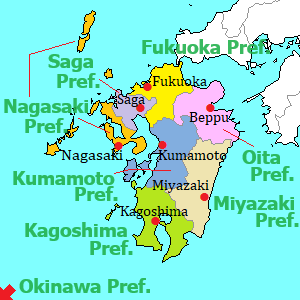
Kyushu was the most western island remote from the ancient capitals Kyoto and Tokyo.
But Kyushu is close to Asian Continent and it was the entrance place to Korea and China in the prehistoric age of Japan.
So, there are the cities and towns with the spots relating to the countries.
Yanagawa (柳川, Fukuoka Pref.) is a castle city near Ariake Sea.
Many canals connecting to the rivers were constructed to defense of the castle.
They are attractive, so Yanagawa is often called the city of water.
Yame (八女, Fukuoka Pref.) is a town producing various traditional specialty goods, especially, "Yame tea" is a popular specialty.
Fukushima district is the central area with many traditional buildings.
Nagasaki (長崎, Nagasaki Pref.) had been the only city connecting foreign countries under national isolation from 1639 to 1854.
So there are many tourist spots with exotic atmosphere.
In addition, Nagasaki was the city that A-bomb was dropped after Hiroshima in 1945.
Hirado (平戸, Nagasaki Pref.) is a castle city to the north of Nagasaki, and was the first place where propagated Christianity was propagated to Japanese people.
So there are the castle, Buddhist temples, and the Christian Church in the old town.
Hita (日田, Oita Pref.) is a castle town in the basin surrounded with many mountains.
Hita area was under direct control of the national government in samurai Period, so the traditional town was formed like Kyoto, Osaka and Edo (Tokyo).

